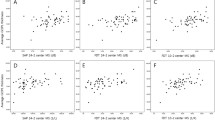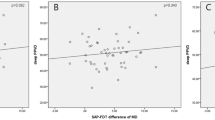Abstract
Purpose
To compare perimetric data based on the second-generation frequency doubling technology (FDT) and on flicker defined form (FDF) stimulation in early glaucoma patients.
Methods
Seventy-two experienced glaucoma patients and 50 healthy subjects of the Erlangen Glaucoma Registry participated in the study. The definition of glaucoma was solely based on optic disc appearance. All patients underwent FDF perimetry (HEP), FDT perimetry (Matrix), standard automated perimetry (SAP, Octopus), and peripapillar measurements of the RNFL thickness (Spectralis OCT). Exclusion criteria were: mean defect (MD) in SAP > 6 dB, eye diseases other than glaucoma, or non-reliable FDF or FDT measurements. Statistical analyses included comparison of the standard indices and correlations between methods. Venn-diagrams show the number of patients with abnormal results in HEP, Matrix, SAP, and mean RNFL thickness.
Results
Mean defect data from FDT and FDF perimetry were strongly correlated (R = −0.85, P <0.001). In this cohort of early glaucoma patients, the MD values were 6.1 ± 5.0 dB (FDF) and 4.5 ± 4.1 dB (FDT). Sensitivity in this patient group was 65 % for FDF-MD, 60 % for FDT-MD, and 60 % for RNFL-thickness, all at a specificity of 95 %. The correlation analysis between local RNFL thickness and corresponding visual defects revealed significant Spearman correlation coefficients for the arcuate bundles of the visual field (FDF-inferior: R = −0.65, FDF-superior: R = −0.74, FDT-inferior: R = −0.55, FDT-superior: R = −0.72).
Conclusion
FDF and FDT stimulations can be used to detect patients with early glaucoma. Combined consideration of RNFL thickness and results from one of these perimetric tests can increase the total number of detected patients.





Similar content being viewed by others
References
Casson R, James B, Rubinstein A, Ali H (2001) Clinical comparison of frequency doubling technology perimetry and Humphrey perimetry. Br J Ophthalmol 85(3):360–362
Paczka JA, Friedman DS, Quigley HA, Barron Y, Vitale S (2001) Diagnostic capabilities of frequency-doubling technology, scanning laser polarimetry, and nerve fiber layer photographs to distinguish glaucomatous damage. Am J Ophthalmol 131(2):188–197
Sample PA, Medeiros FA, Racette L, Pascual JP, Boden C, Zangwill LM, Bowd C, Weinreb RN (2006) Identifying glaucomatous vision loss with visual-function-specific perimetry in the diagnostic innovations in glaucoma study. Invest Ophthalmol Vis Sci 47(8):3381–3389
Anderson AJ, Johnson CA (2003) Frequency-doubling technology perimetry. Ophthalmol Clin North Am 16(2):213–225
Tyler CW (1981) Specific deficits of flicker sensitivity in glaucoma and ocular hypertension. Invest Ophthalmol Vis Sci 20(2):204–212
Nomoto H, Matsumoto C, Takada S, Hashimoto S, Arimura E, Okuyama S, Shimomura Y (2009) Detectability of glaucomatous changes using SAP, FDT, flicker perimetry, and OCT. J Glaucoma 18(2):165–171
Matsumoto C, Takada S, Okuyama S, Arimura E, Hashimoto S, Shimomura Y (2006) Automated flicker perimetry in glaucoma using Octopus 311: a comparative study with the Humphrey Matrix. Acta Ophthalmol Scand 84(2):210–215
Zeppieri M, Brusini P, Parisi L, Johnson CA, Sampaolesi R, Salvetat ML (2010) Pulsar perimetry in the diagnosis of early glaucoma. Am J Ophthalmol 149(1):102–112
Salvetat ML, Zeppieri M, Tosoni C, Parisi L, Brusini P (2010) Non-conventional perimetric methods in the detection of early glaucomatous functional damage. Eye (Lond) 24(5):835–842
Lachenmayr BJ, Drance SM, Douglas GR, Mikelberg FS (1991) Light-sense, flicker and resolution perimetry in glaucoma: a comparative study. Graefes Arch Clin Exp Ophthalmol 229(3):246–251
Horn FK, Jonas JB, Korth M, Junemann A, Grundler A (1997) The full-field flicker test in early diagnosis of chronic open-angle glaucoma. Am J Ophthalmol 123(3):313–319
Racette L, Medeiros FA, Zangwill LM, Ng D, Weinreb RN, Sample PA (2008) Diagnostic accuracy of the Matrix 24–2 and original N-30 frequency-doubling technology tests compared with standard automated perimetry. Invest Ophthalmol Vis Sci 49(3):954–960
Sample PA, Bosworth CF, Blumenthal EZ, Girkin C, Weinreb RN (2000) Visual function-specific perimetry for indirect comparison of different ganglion cell populations in glaucoma. Invest Ophthalmol Vis Sci 41(7):1783–1790
Spry PG, Johnson CA, Mansberger SL, Cioffi GA (2005) Psychophysical investigation of ganglion cell loss in early glaucoma. J Glaucoma 14(1):11–19
Kamantigue ME, Joson PJ, Chen PP (2006) Prediction of visual field defects on standard automated perimetry by screening C-20-1 frequency doubling technology perimetry. J Glaucoma 15(1):35–39
Medeiros FA, Sample PA, Weinreb RN (2004) Frequency doubling technology perimetry abnormalities as predictors of glaucomatous visual field loss. Am J Ophthalmol 137(5):863–871
Landers JA, Goldberg I, Graham SL (2003) Detection of early visual field loss in glaucoma using frequency-doubling perimetry and short-wavelength automated perimetry. Arch Ophthalmol 121(12):1705–1710
Heeg GP, Blanksma LJ, Hardus PL, Jansonius NM (2005) The Groningen Longitudinal Glaucoma Study. I Baseline sensitivity and specificity of the frequency doubling perimeter and the GDx nerve fibre analyser. Acta Ophthalmol Scand 83(1):46–52
Johnson CA, Demirel S (1997) The role of spatial and temporal factors in frequency-doubling perimetry. In: Wall M, Heijl A (eds) Perimetry Update 1996/1997; Proceeding of the XIIth International Perimetric Society Meeting. Kugler Publications, Amsterdam, pp 13–19
Quaid PT, Flanagan JG (2005) Defining the limits of flicker defined form: effect of stimulus size, eccentricity and number of random dots. Vision Res 45(8):1075–1084
Lamparter J, Russell RA, Schulze A, Schuff AC, Pfeiffer N, Hoffmann EM (2012) Structure-function relationship between FDF, FDT, SAP, and scanning laser ophthalmoscopy in glaucoma patients. Invest Ophthalmol Vis Sci 53(12):7553–7559
Horn FK, Tornow RP, Junemann AG, Laemmer R, Kremers J (2014) Perimetric measurements with flicker-defined form stimulation in comparison with conventional perimetry and retinal nerve fiber measurements. Invest Ophthalmol Vis Sci 55(4):2317–2323
Jonas JB, Gusek GC, Naumann GO (1988) Optic disc morphometry in chronic primary open-angle glaucoma. I Morphometric intrapapillary characteristics. Graefes Arch Clin Exp Ophthalmol 226(6):522–530
Jonas JB, Budde WM, Panda-Jonas S (1999) Ophthalmoscopic evaluation of the optic nerve head. Surv Ophthalmol 43(4):293–320
Hodapp E, Parrish RK, Anderson DR (1993) Clinical decisions in glaucoma. In: CV Mosby (ed) Co., St. Louis, p 52–61
Lauterwald F, Neumann CP, Lenz R, Jünemann AG, Mardin CY, Meyer-Wegener K, Horn FK (2012) The erlangen glaucoma registry: a scientific database for longitudinal analysis of glaucoma. Technical reports / Dep Informatik (ISSN 2191–5008) CS-2011,2:1–9.
Horn FK, Mardin CY, Laemmer R, Baleanu D, Juenemann AM, Kruse FE, Tornow RP (2009) Correlation between local glaucomatous visual field defects and loss of nerve fiber layer thickness measured with polarimetry and spectral domain OCT. Invest Ophthalmol Vis Sci 50(5):1971–1977
Johnson CA, Cioffi GA, Van Buskirk EM (1999) Frequency doubling technology perimetry using a 24–2 stimulus presentation pattern. Optom Vis Sci 76(8):571–581
Turpin A, McKendrick AM, Johnson CA, Vingrys AJ (2002) Performance of efficient test procedures for frequency-doubling technology perimetry in normal and glaucomatous eyes. Invest Ophthalmol Vis Sci 43(3):709–715
Quaid PT, Simpson TL, Flanagan JG (2005) Frequency doubling illusion: detection vs. form resolution. Optom Vis Sci 82(1):36–42
Goren D, Flanagan JG (2008) Is flicker-defined form (FDF) dependent on the contour? J Vis 8(4):15.1–11
Bland J, Altman D (1986) Statistical methods for assessing agreement between two methods of clinical measurement. Lancet 1:307–310
Bendschneider D, Tornow RP, Horn FK, Laemmer R, Roessler CW, Juenemann AG, Kruse FE, Mardin CY (2010) Retinal nerve fiber layer thickness in normals measured by spectral domain OCT. J Glaucoma 19(7):475–482
Rodgers P, Stapleton G, Flower J, Howse J (2014) Drawing area-proportional euler diagrams representing up to three sets. IEEE Trans Vis Comput Graph 20(1):56–69
Oliveros JC (2007) VENNY. An interactive tool for comparing lists with Venn Diagrams. http://bioinfogp.cnb.csic.es/tools/venny/index.html. Accessed 24 Oct 2014
Vergara IA, Norambuena T, Ferrada E, Slater AW, Melo F (2008) StAR: a simple tool for the statistical comparison of ROC curves. BMC Bioinf 9:265
Horn FK, Mardin CY, Bendschneider D, Junemann AG, Adler W, Tornow RP (2011) Frequency doubling technique perimetry and spectral domain optical coherence tomography in patients with early glaucoma. Eye (Lond) 25(1):17–29
Bowd C, Zangwill LM, Berry CC, Blumenthal EZ, Vasile C, Sanchez-Galeana C, Bosworth CF, Sample PA, Weinreb RN (2001) Detecting early glaucoma by assessment of retinal nerve fiber layer thickness and visual function. Invest Ophthalmol Vis Sci 42(9):1993–2003
Horn FK, Brenning A, Junemann AG, Lausen B (2007) Glaucoma detection with frequency doubling perimetry and short-wavelength perimetry. J Glaucoma 16(4):363–371
Sakata LM, Deleon-Ortega J, Arthur SN, Monheit BE, Girkin CA (2007) Detecting visual function abnormalities using the Swedish interactive threshold algorithm and matrix perimetry in eyes with glaucomatous appearance of the optic disc. Arch Ophthalmol 125(3):340–345
Gobel K, Poloschek CM, Erb C, Bach M (2012) Importance of flicker contrast tests in functional glaucoma diagnostics. Ophthalmologe 109(4):319–324
Yoshiyama KK, Johnson CA (1997) Which method of flicker perimetry is most effective for detection of glaucomatous visual field loss? Invest Ophthalmol Vis Sci 38(11):2270–2277
Dannheim F (2013) Flicker and conventional perimetry in comparison with structural changes in glaucoma. Ophthalmologe 110(2):131–140
Mulak M, Szumny D, Sieja-Bujewska A, Kubrak M (2012) Heidelberg edge perimeter employment in glaucoma diagnosis--preliminary report. Adv Clin Exp Med 21(5):665–670
May F, Giraud J-M, Francoz M, El Chehab H, Fenolland J-R, Sendon D, Denier C, El Asri F, Dieng M, Renard J-P (2012) Heidelberg Edge Perimetry: evaluation of the Flicker Defined Form test, versus Matrix, in normal and glaucoma subjects. Investig Ophthalmol Vis Sci. 53:E-Abstract 186.
Lamparter J, Schulze A, Schuff AC, Berres M, Pfeiffer N, Hoffmann EM (2011) Learning curve and fatigue effect of flicker defined form perimetry. Am J Ophthalmol 151(6):1057–1064
Horn FK, Kremers J, Mardin CY, Junemann AG, Adler W, Tornow RP (2015) Flicker-defined form perimetry in glaucoma patients. Graefes Arch Clin Exp Ophthalmol 253(3):447–455
Prokosch V, Eter N (2014) Correlation between early retinal nerve fiber layer loss and visual field loss determined by three different perimetric strategies: white-on-white, frequency-doubling, or flicker-defined form perimetry. Graefes Arch Clin Exp Ophthalmol 252(10):1599–1606
Hong S, Ahn H, Ha SJ, Yeom HY, Seong GJ, Hong YJ (2007) Early glaucoma detection using the Humphrey Matrix Perimeter, GDx VCC, Stratus OCT, and retinal nerve fiber layer photography. Ophthalmology 114(2):210–215
Reznicek L, Lamparter J, Vogel M, Kampik A, Hirneiss C (2015) Flicker defined form perimetry in glaucoma suspects with normal achromatic visual fields. Curr Eye Res 40(7):683–689
Author information
Authors and Affiliations
Corresponding author
Ethics declarations
Funding
No financial support was received for the study. The Matrix and the HEP instruments were given as loan from the manufacturers for the time of the study. The manufacturers had no role in the design or conduct of this research.
Conflict of interest
All authors certify that they have no affiliations with or involvement in any organization or entity with any financial interest (such as honoraria; educational grants; participation in speakers’ bureaus; membership, employment, consultancies, stock ownership, or other equity interest; and expert testimony or patent-licensing arrangements), or non-financial interest (such as personal or professional relationships, affiliations, knowledge or beliefs) in the subject matter or materials discussed in this manuscript.
Ethical approval
All procedures performed in studies involving human participants were in accordance with the ethical standards of the institutional and/or national research committee and with the 1964 Helsinki declaration and its later amendments or comparable ethical standards.
Informed consent
Informed consent was obtained from all individual participants included in the study.
Rights and permissions
About this article
Cite this article
Horn, F.K., Scharch, V., Mardin, C.Y. et al. Comparison of frequency doubling and flicker defined form perimetry in early glaucoma. Graefes Arch Clin Exp Ophthalmol 254, 937–946 (2016). https://doi.org/10.1007/s00417-016-3286-1
Received:
Revised:
Accepted:
Published:
Issue Date:
DOI: https://doi.org/10.1007/s00417-016-3286-1




